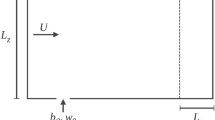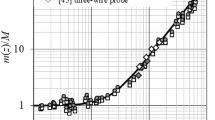Abstract
The behaviour of stationary, non-passive plumes can be simulated in a reasonably simple and accurate way by integral models. One of the key requirements of these models, but also one of their less well-founded aspects, is the entrainment assumption, which parameterizes turbulent mixing between the plume and the environment. The entrainment assumption developed by Schatzmann and adjusted to a set of experimental results requires four constants and an ad hoc hypothesis to eliminate undesirable terms. With this assumption, Schatzmann’s model exhibits numerical instability for certain cases of plumes with small velocity excesses, due to very fast radius growth. The purpose of this paper is to present an alternative entrainment assumption based on a first-order turbulence closure, which only requires two adjustable constants and seems to solve this problem. The asymptotic behaviour of the new formulation is studied and compared to previous ones. The validation tests presented by Schatzmann are repeated and it is found that the new formulation not only eliminates numerical instability but also predicts more plausible growth rates for jets in co-flowing streams.
Similar content being viewed by others
References
Briggs, G.A., Plume rise and buoyancy effects. In: D. Randerson (ed.),Atmospheric Science and Power Production, U.S. Dept. of Energy DOE/TIC-27601 (1984) pp. 327–366.
Chu, V.H. and Goldberg, M.B., Buoyant forced-plumes in cross-flow.J. Hydraulics Division of the ASCE 100 (1974) 10805–10808.
Csanady, G.T.,Turbulent Diffusion in the Environment, Geophysics and Astrophysics Monographs, D. Reidel Publishing Company, Dordrecht (1973) 248 pp.
Davidson, G.A., A discussion of Schatzmann’s integral plume model from a control volume viewpoint.J. Climate Appl. Meteorol. 25 (1986) 858–867.
Fan, L.N., Turbulent buoyant jets into stratified or flowing ambient fluids. California Institute of Technology, Report No. KH-R-15, Pasadena, CA (1967).
Fink, L., Der axialsymmetrische Strahl in einer turbulenten Grundströmung. SFB 80, Universität Karlsruhe, Report No. SFB 80/ET/20 (1974).
Fox, D.G., Forced plume in a stratified fluid.J. Geophys. Res. 75 (1970) 6818–6835.
Hirst, E., Buoyant jets discharged to quiescent stratified ambients.J. Geophys. Res. 76 (1971) 7375–7384.
Hirst, E., Buoyant jets with tree-dimensional trajectories.J. Hydraulics Division of the ASCE 98 (1972) 1999–2014.
Hoult, D.P., Fay, J.A. and Forney, L.J., A theory of plume rise compared with field observations.J. Air Pollut. Control Ass. 19 (1969) 585–590.
Middleton, J.H., The rise of forced plumes in a stably stratified crossflow.Boundary-Layer Meteorol. 36 (1986) 137–199.
Morton, B.R., Forced plumes.J. Fluid Mech. 5 (1959) 151–163.
Morton, B.R., Taylor, G.I. and Turner, J.S., Turbulent gravitational convection from maintained and instantaneous sources.Proc. Roy. Soc. London A234 (1956) 1–23.
Moussa, Z.M., Trischka, J.W. and Eskinazi, S., The near field in the mixing of a round jet with cross-stream.J. Fluid Mech. 80 (1977) 49–80.
Priestley, C.H.D., A working theory of the bent-over plume of hot gas.Quart. J. Roy. Met. Soc. 82 (1956) 165–176.
Priestley, C.H.D. and Ball, F.K., Continuous convection from an isolated source of heat.Quart. J. Roy. Meteorol. Soc. 81 (1955) 144–157.
Schatzmann, M., The integral equations for round buoyant jets in stratified flows.J. Appl. Math. Phys. (ZAMP) 29 (1978) 608–630.
Schatzmann, M., An integral model of plume rise.Atmos. Environ. 13 (1979) 721–731.
Schatzmann, M. and Policastro, A.J., Effects of the Boussinesq approximation on the results of strongly buoyant plume calculations.J. Climate Appl. Meteorol. 23 (1984) 117–123.
Slawson, P.R. and Csanady, G.T., On the mean path of buoyant, bent-over chimney plumes.J. Fluid Mech. 28 (1967) 311–322.
Slawson, P.R. and Csanady, G.T., The effect of atmospheric conditions on plume rise.J. Fluid Mech. 47 (1979) 39–49.
Weil, J.C., Plume rise. In: Venkatram, A. and Wyngaard, J.C. (eds),Lectures on Air Pollution Modeling. American Meteorological Society, Boston (1988) pp. 119–162.
Author information
Authors and Affiliations
Rights and permissions
About this article
Cite this article
Teixeira, M.A.C., Miranda, P.M.A. On the entrainment assumption in Schatzmann’s integral plume model. Appl. Sci. Res. 57, 15–42 (1996). https://doi.org/10.1007/BF02528762
Received:
Accepted:
Issue Date:
DOI: https://doi.org/10.1007/BF02528762




